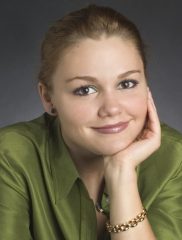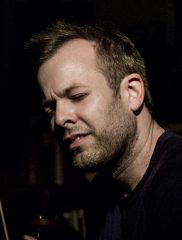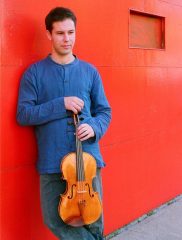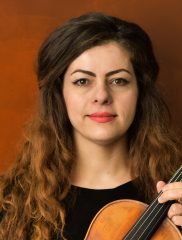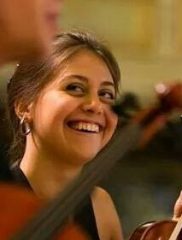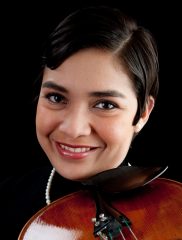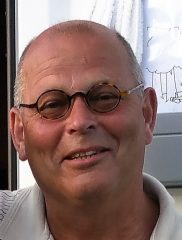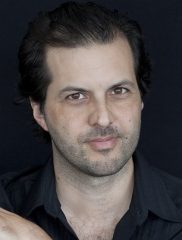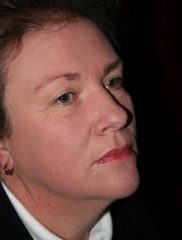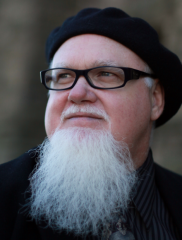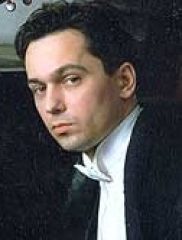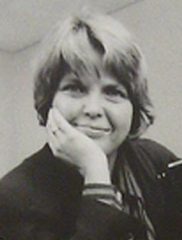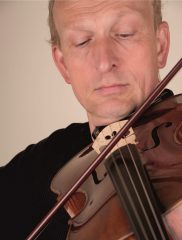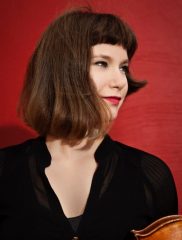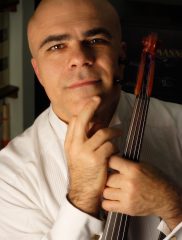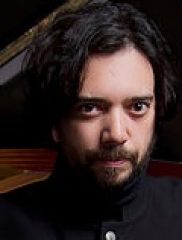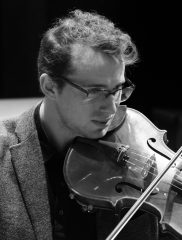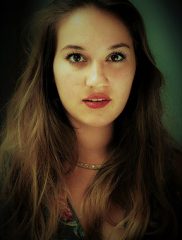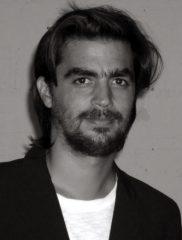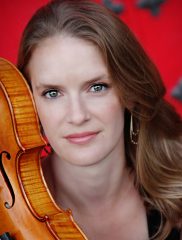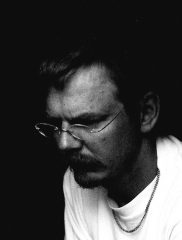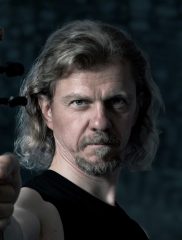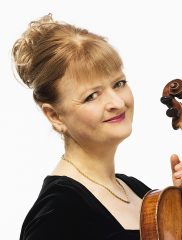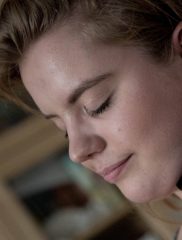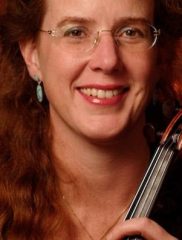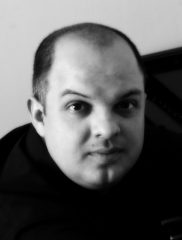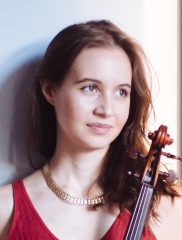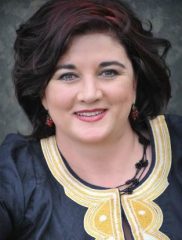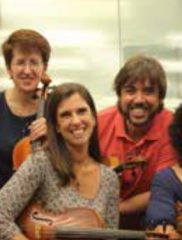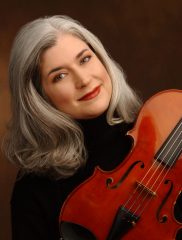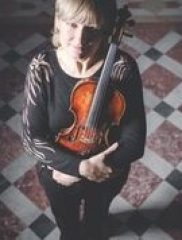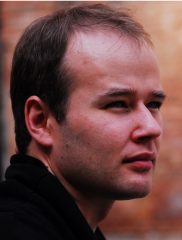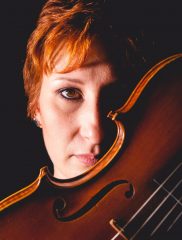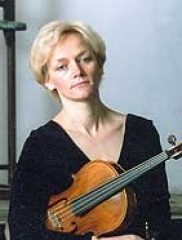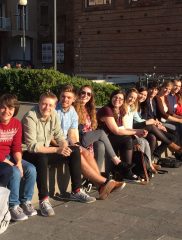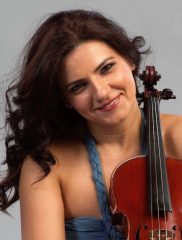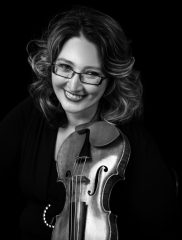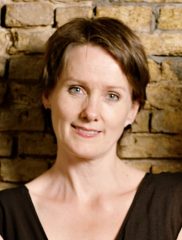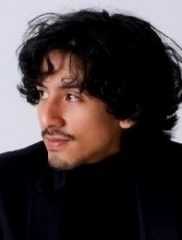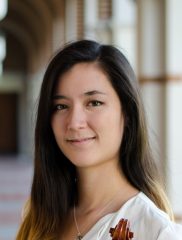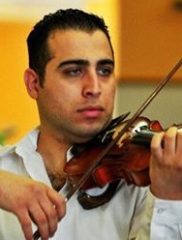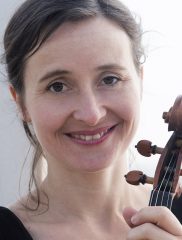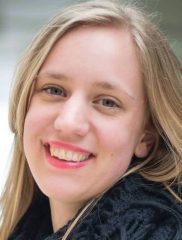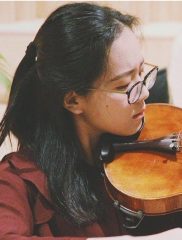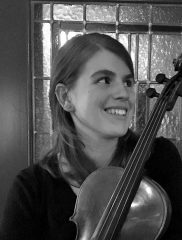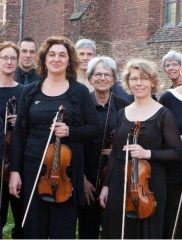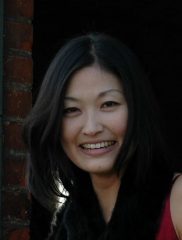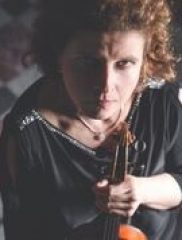Recitals Lecture-Recitals Lectures Masterclasses Workshops
Gallery of IVC2018 Recital Presenters:
Exact schedule information will be maintained separately in Sched, our online programme guide (soon to be available to the public!).
Below are some examples of the many Recitals held at IVC2018.
Presenters: Kellen McDaniel (USA), Kardelen Buruk (Turkey) – violas
Accompanist: N/A
Date: Saturday Nov 24th, afternoon, main stage;
Duration: 20 minutes
Seasoned viola Duo Black Büyü presents a world premiere commission at IVC Rotterdam 2018. Composed by violist Kellen McDaniel, Moonwalk is a new kind of work which pushes the boundaries of what two violists can do in concert. A semi staged piece, Moonwalk tells the story of an encounter in space between two travellers who overcome their differences through a shared affinity for the viola. Including elements of drama, dance, singing, electronics and more, Moonwalk charts an unforgettable journey demonstrating the power of the viola to help us overcome the distances between us and to bridge our cultural divides.

Black Büyü is a classical viola duo featuring Kardelen Buruk and Kellen McDaniel. With a diverse repertoire, rich in both contemporary and classical music, Black Büyü presents a one of a kind concert experience. Also composers and arrangers, Black Büyü is constantly adding new covers and original music to their show.
Kellen McDaniel is a violist, composer and graduate of The Juilliard School (Bachelor of Music, 2013) and The Royal Conservatoire of The Netherlands (Master of Music, 2015), now pursuing an advanced Master of Chamber Music at The Royal Conservatoire of The Netherlands. Born and raised in Los Angeles, solo and chamber performances featured by Ameropa International Music Festival (Prague), Schlern International Music Festival (Italy) Banff Masterclasses (Canada), The Heifetz Institute (USA), Music Academy of the West (USA), Harmos Festival (Portugal), Aspen Music Festival (USA), PODIUM Festival (Germany), Bundes Jugend Ballet Hamburg (Germany), International Summer Academy (Austria). He was a semi finalist at the Washington International String Competition (2012) and plays on a Geoffrey Ovington viola and bow courtesy of the Maestro Foundation of Santa Monica. Kellen McDaniel
is a founding member of Babylon String Quartet (based in The Hague), which won “De Grote Kammermusikprijs” 2015, and was a finalist at Grachtenfestival Concours 2016. They have been featured in many concert series such as Jenine Jenson and Friends, Delft Chamber Music Festival, Grachtenfestival, ECMA Session Vilnius, and more. They have been broadcast on Radio 4 and 1 in The Netherlands. Kellen, along with his brother Marshall co-composed a new work for string quartet and electronics called Ghosts, which was premiered by Babylon Quartet in a showcase at Classical:NEXT 2016, a new music technology expo. The Kersjesfonds awarded Babylon Quartet its String Quartet Bursary in 2016 for their innovative concert offerings and substantial traditional underpinnings.
Kardelen Buruk was born in Ankara in 1996. She participated in AIMS Festival and she worked with Prof. Ulrich Knörzer (viola) and Johannes Geffer (chamber orchestra). She performed in concerts of solo viola and chamber orchestra within AIMS Festival. In 2013 Summer She participated a masterclass in Idyllwild Academy in US with full scholarship. She worked on solo and also chamber music with Gina Coletti. At the same time she played at chamber music orchestra of Idyllwild Academy which was conducted by Larry Livingston.
In 2014, she graduated from her conservatory (MSFAU) with 9.64 grade points in Istanbul. She entered the entrance exam of Royal Conservatory of the Hague in April 2014 and she was chosen for first year classical viola in Bachelor. In 2014 Summer she attented to Apeldoorn International Music Masterclass and she had lessons with Nobuko Imai and also with Asdis Valdimarsdottir. She attended Garth Knox’s masterlass with her viola duo (Everything is O.K) and presented one his viola piece from his ‘Viola Spaces’ composition.
In the summer of 2015 she made the audition for IOIA (International Orchestra Institute Attergau). It was an orchestra project under the Patronage of the Vienna Philharmonic. In Cooperation with the Institute for Viennese Sound & Style of the University of Music in Vienna. The orchestra had two concerts in St. Attergau and it was conducted by Leopold Hager. She was chosen for the assistant principal place.
In 2016, she auditioned for the NSO (Nederland Studenten Orkest) and she played as an assistant principal. They had 12 concerts in Netherlands in the greatest halls as the Concertgebouw, De Doelen. In performance with her viola duo, she has concertized all over the Netherlands. She performed with Het Metropole Orchestra in The Royal Concertgebouw in Amsterdam. She got accepted to ISA (International Summer Academy in Austria for the summer 2016 (14th of August- 28th of August) where she gave solo concerts and premiered a new composition by a Lithuanian composer for
viola, clarinet and piano. She worked with Gilad Karni and Miguel de Silva.
The september 2017 she had a privilege to play in an orchestra which was conducted by Valery Gergiev. Recently her viola duo (EVERYTHING IS O.K) recorded the composition called Corp that was written by Boelo de Smit for them. In October 2016 EVERYTHING IS OK travelled to the 43rd International Viola Congress in Cremona, Italy to present a performance of Corp for the congress. In February of 2017 Kardelen competed in the quarter-finals of The Amsterdam Viola Competition in the Sweelinckzaal of Amsterdam Conservatory.
The summer of 2017 she had a chance to work with Paul Colletti. At the same time she played in an ensemble featured by Philippe Graffin and Asdis Valdimarsdottir.
Presenters: Lech Balaban (viola), Poland
Accompanist: Krzysztof Sowiński (piano)
Date: Wednesday Nov 21st, morning, GKV reformed church;
Duration: 30 minutes
Programme:
Ph. Scharwenka: Sonata for viola and piano G-minor Op. 106
S. Czarnecki: Sonata Kujawska for viola and piano Op. 56 (2016)
The first piece is Sonata op.106 by Philipp Scharwenka, known as German composer of late Romantic era. Scharwenka was born in Szamotuły, a town in the Wielkopolska voivodship, and started their musical education in Poznań. Viola Sonata in G minor, Op. 106, published for the first time in 1899, is his only viola sonata. Although it is performed without pauses as a single entity, it is internally divided into three parts: Fantasia, Allegretto and Allegro.
Sławomir Czarnecki’s Sonata Kujawska was created on the initiative of Lech Bałaban and is dedicated to him. It consists traditionally of three parts. The elements of tradition include folk melodic themes. Modernist elements in the work are – structural thinking, repetitiveness, elements of minimal music.
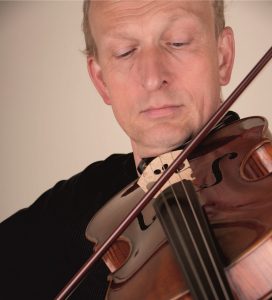
Lech Balaban
Lech Bałaban began learning violin at the age of 5 with his father Henryk Bałaban and remained under his tutelage until he was a sophomore. Later he studied under the supervision of Professor Jadwiga Kaliszewska; in 1988 he graduated from her class at the I. J. Paderewski Academy of Music in Poznań and in 1994 he earned his diploma in viola. He perfected his skills in master courses under the direction of Professors E. Feltz, Z. Bron. O. Kagan, W. Pikajzen, M. Frischenschlagger, and R. Ricci. He won special prize at the 4th Polish Young Violinist Festival in Lublin (1980), prize at the 4th Z. Jahnke Polish Violinist Festival in Poznań (1984), and fi rst prize at the 5th J. Rakowski Polish Violist Competition in Poznań (1993). He was also a member of the Polish team participating in the 9th H. Wieniawski International Violin Competition in Poznań (1986). As a violist he had his debut playing a solo part of A. Schönberg’s string sextet Verklärte Nacht as a concert master of the “Amadeus” Chamber Orchestra of the Polish Radio under Agnieszka Duczmal, of which he has been a member since 1988. As a soloist he performed in many Polish cities as well as in Denmark, Slovakia, Germany, Austria, France, and the USSR. Together with the “Amadeus” Chamber Orchestra he recorded viola concertos of J. Ch. Bach, G. F. Händel, K. Penderecki, M. Stachowski, Piotr Wróbel’s Violet Rhapsody, and W. A. Mozart’s Sinfonia Concertante (with Jarosław Żołnierczyk), and premiered viola concertos composed for him: Piotr Wróbel’s Violet Rhapsody, Zbigniew Kozub’s Viola Concerto, Sławomir Czarnecki’s Ursyn Concerto, Piotr Moss’ Récit IV – concerto for viola and strings. Lech Bałaban was an offi cial violist of the 14th Henryk Wieniawski International Violin Competition in Poznań performing W. A. Mozart’s Sinfornia Concertante in E-fl at major KV 364 with the “Amadeus” Chamber Orchestra of the Polish Radio under Agnieszka Duczmal. He performed at prestigious “Bravo Maestro” Festivals with such musicians as Wanda Wiłkomirska, Ewa Pobłocka, Wadim Brodski, Konstanty Andrzej Kulka, Krzysztof Jakowicz, Kuba Jakowicz, Waldemar Malicki, and Tomasz Strahl. He is a member of the “Wieniawski Kwartet” string quartet with which he has recorded, among others, a set of string quartets of Krzysztof Meyer for NAXOS record company. He also performed with Piotr Pławner. He plays in the Bałaban Family Quartet with his wife and sons Wiktor and Jan. In December 2014 the ensemble’s fi rst record with Antonin Dvořák’s chamber pieces was released. Lech Bałaban works as a professor at the Academy of Music in Bydgoszcz and leads a viola class at the Academy of Music in Poznań. Until 2017 he was a pedagogue at The Poznań School of Talents where he educated several laureates of music competitions. In February 2011 he earned his degree of habilitated doctor of music arts. He is a lecturer at the International Music Courses in Łańcut, „Music of Our Times” Workshops in Inowrocław, and founder and artistic director of the “Play with Master” course in Gniezno. Since 1992 he has been performing in a duet with pianist Krzysztof Sowiński. Lech Bałaban is the vice-president of the Polish Viola Society.

Krzysztof Sowiński
Krzysztof Sowiński graduated with distinction from Professor Alicja Kledzik’s piano class at the I. J. Paderewski Academy of Music in Poznań. In 1992 he earned 3rd prize at the C. Kahn’s European Piano Competition in Paris. He was awarded artistic grants from the F. Chopin Society in Warsaw, F. Liszt Society in Wrocław, and the Ministry of Culture and Art. He has been performing as a soloist and chamber musician throughout Poland and in Germany, Russia, Sweden, Spain, Italy (Sicily), and Hungary. He partnered such soloists as: Iwona Hossa, Jadwiga Kaliszewska, Bartosz Bryła, Jarosław Żołnierczyk, Stefan Kamasa, Lech Bałaban, Katarzyna Budnik Gałązka, Dominik Połoński, Roman Jabłoński and Andrzej Wróbel, and many others. He made many CD recordings: Forgotten and New Pieces for Clarinet by the Szczecin Composers of the 19th, 20th and 21st centuries, Sonatas, Xaver Scharwenka – piano & chamber music and other. In the years 1993-2001 he was an assistant in Professor Waldemar Andrzejewski’s piano class. He is a lecturer at piano workshops, a member of juries at Polish and European music competitions. He premiered numerous chamber music pieces. Currently, he works as an associate professor in the Department of Chamber Music at the Academy of Music in Poznań. He is also holding the function of the dean of the Faculty of String Instruments, Harp, Guitar and Violinmaking.
Presenters: Gillian Ansell (New Zealand) and Atar Arad (USA)
Accompanist: N/A
Date: Saturday Nov 24th, afternoon, GKV reformed church;
Duration: 15 minutes
Programme:
Atar Arad: Toccatina a la Turk
Atar Arad: Esther
Two rarely-heard works by illustrious violist-composer and IVC2018 Featured Artist Atar Arad, who will also be performing.
Violist Gillian Ansell was born in Auckland, New Zealand and made her concerto debut as a violinist with the Auckland Philharmonia at the age of 16. At 19, an Associated Board Scholarship took Gillian to the Royal College of Music in London for 3 years to study violin, viola and piano. She then won a German Academic Exchange (DAAD) scholarship for further study in Germany at the Musikhochschule Cologne with Igor Ozim and the Amadeus Quartet.

Gillian Ansell
After working in London for three years Gillian returned to New Zealand in 1987 to become a founding member of the New Zealand String Quartet. She was second violinist for two years before taking up the position of violist with the group. In 2017 she celebrated 30 years playing in the quartet, with whom she has toured New Zealand and the world, playing a wide repertoire including cycles of Beethoven, Bartok, Berg and premiering many New Zealand works. The quartet has recorded over 20 CDs, including the complete Mendelssohn and Brahms quartets for Naxos.
Since 1991, Gillian and the other members of the New Zealand String Quartet have been on the faculty of the New Zealand School of Music at Victoria University of Wellington.
In 2001 she became Artistic Director, with fellow quartet member Helene Pohl, of the Adam New Zealand Chamber Music Festival and in 2008 she was made a Member of the New Zealand Order of Merit (MNZM) for her outstanding services to music in New Zealand.
Gillian plays a 1619 Nicolò Amati viola, generously loaned by the Adam Foundation. In her spare time she likes to hike, cook and garden.
Atar Arad is one of the IVC2018 Featured Artists. You can read his biography here
Presenters: Henrik Frendin (viola), Henrik Frisk (electronics) – Sweden
Accompanist: N/A
Date: Thursday Nov 22nd, evening, main stage;
Duration: 30 minutes

Henrik Frendin
Constructing an amplified string instrument without loss of acoustical sound character is not an easy task. The innovative Swedish instrument maker Richard Rolf has faced the challenge. In collaboration with Henrik Frendin, fifteen years of research were required to develop a unique invention with unprecedented sound qualities. The first prototype, a 5-string electric viola grande was built in 2001.
Ten years later, the next instrument was ready: a ”normal” 4-string viola with major construction improvements. His deep insights into traditional instrument making, in combination with cutting edge microphone technique, resulted in an entirely new instrument. The authentic sound quality has opened up new possibilities of creating music in performance environments that require amplification. The characteristic human voice of the viola is the fundamental element for limitless transformations of sound, when processed through a computer.

Henrik Frisk
The Frendin & Frisk duo was formed in 2002 and has since then made numerous performances in Europe and North America.
This recital will be a presentation of the development of this unique instrument and its possibilities. Some exciting new interactive compositions by the artists will be performed.
Welcome to the musical playground of the 21st century.
The sky is the limit …
Presenters: Frida Siegrist Oliver (viola), Norway
Accompanist: Caecilia Boschman (piano), The Netherlands
Date: Tuesday Nov 20th, afternoon, main stage;
Duration: 20 minutes
Programme:
Harald Sæverud: Sonatina for viola and piano (10′)
Edvard Grieg: Violin sonata no.3 op.45, 2nd mvt. (7′) (arr.)
Some violists tend to stick to the same small amount of the repertoire available, but still complain about how little repertoire there is. With this recital I wish to introduce a very specific part of the viola repertoire, the Norwegian viola music. There is so much music written for viola by Norwegian composers that’s extremely rarely played outside of Norway. I will perform the 2nd movement of Grieg’s 3rd violin sonata on viola, it is a beautiful piece that should be a part of the viola repertoire. Harald Sæverud also wrote a sonatina for viola and piano which is hardly known outside of Norway.

Frida Siegrist Oliver
Frida Oliver (19) began her music studies at the age of 5 on the violin, switching to viola at age 8. A native of Stavanger, Norway, Frida regularly works as a substitute in Stavanger Symphony Orchestra and the Oslo Philharmonic. She attended Pre-College at Barratt-Due Institute of Music from she was 10 until she was 18. From 2011-2012, Frida attended the chamber music festival Musica Mundi in Belgium. Since 2013 Frida has been a member of the Perlman Music Program. She is currently a sophomore studying with Heidi Castleman and Carol Rodland at The Juilliard School in New York.
Presenter: Ásdís Valdimarsdóttir (viola), Iceland
Accompanist: Marcel Worms (piano), Netherlands
Date: Friday Nov 23rd, afternoon, main stage;
Duration: 30 minutes
Mieczyslaw Weinberg (1919-96): Sonata op. 28
Dick Kattenburg (1919-1944): Moderato
Ásdís and Marcel have just released a CD (August 2018), with the sonatas of Weinberg and Shostakovich – who were great friends. Also on this CD is the Kattenburg sonata movement and the sonata by Hans Gal.
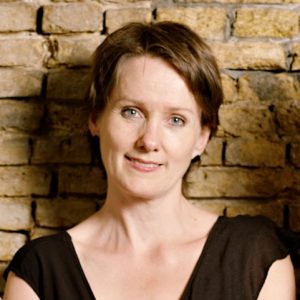 Ásdís Valdimarsdóttir is an internationally renowned Violist, Chamber Musician, Viola Teacher, and Chamber Music Coach, currently on the faculty of the Royal Conservatory in The Hague. Initially, Ásdís began her music studies in Iceland as a violinist. While attending the Reykjavík music school when she was 15, she heard a professional violist play a recital for the first time and she knew from then on that the viola was her instrument. Iceland, a sparsely populated country, had very few viola players at the time and it was not until Ásdís went to study at The Juilliard School that her playing and understanding of the instrument soared.
Ásdís Valdimarsdóttir is an internationally renowned Violist, Chamber Musician, Viola Teacher, and Chamber Music Coach, currently on the faculty of the Royal Conservatory in The Hague. Initially, Ásdís began her music studies in Iceland as a violinist. While attending the Reykjavík music school when she was 15, she heard a professional violist play a recital for the first time and she knew from then on that the viola was her instrument. Iceland, a sparsely populated country, had very few viola players at the time and it was not until Ásdís went to study at The Juilliard School that her playing and understanding of the instrument soared.
Her true passion for the instrument and for chamber music in particular makes Ásdís’ work as a musician and teacher fulfilling on a daily basis. Born in Reykjavik, Iceland in 1962, she studied at the Juilliard School in New York with Paul Doktor, William Lincer, Felix Galimir and the Juilliard Quartet. After graduating with a Bachelor’s and Master’s degree in Music she continued her studies at Detmold, Germany with Nobuko Imai. Mrs Imai was a true inspiration to her; musically, technically and personally and continues to be a source of inspiration. During her studies in Germany, Ásdís was principal viola of the Deutsche Kammer Akademie Neuss, a small string ensemble led by the cellist Johannes Goritski.
Ásdís returned to America to be a founding member of the Miami String Quartet, with whom she won the first prize of the Fischoff Chamber Music Competition. There she was also a Professor of viola at the New World School of the Arts. She went on to become the principal viola of the Deutsche Kammerphilharmonie Bremen in 1990, with whom she worked closely with many great artists, such as Heinrich Shiff, Gidon Kremer, Walter Levine and Sandor Vegh.
In 1995 Ásdís joined the Chilingirian String Quartet and was their violinist until 2003. With them she travelled extensively, made numerous CD and radio recordings and was in residence as a Chamber Music Coach at the Royal College of Music in London. She left the Quartet when her daughter was 2 years old- finding motherhood and the demands of the internationally travelling quartet impossible to combine in a satisfactory way. Since then she has become increasingly passionate about teaching; first holding a professorship at the Royal Northern College of Music in Manchester for 7 years before eventually moving all her regular teaching to the Royal Conservatory The Hague. Over the years she has participated in many prestigious music festivals around the world, such as Marlboro, Kuhmo, Lockenhaus, Davos, Berliner Festspiele, Prussia Cove, Bath, St. Nazaire, Prades and Festival Inverno in Brazil where she has performed and taught. She has appeared as a soloist with the London Mozart Players, the London Soloists Chamber Orchestra, the Russian National Orchestra, Het Brabants Orkest and the Iceland Symphony Orchestra.
Currently, Ásdís is based in Amsterdam and is on the faculty of The Royal Conservatory in The Hague and annually at the International Masterclass in Apeldoorn, NL, for viola and chamber music. She enjoys a mixture of solo and chamber music playing and is a member of two ensembles; The Erard Ensemble- a piano quartet that uses pianos made by Sebastien Erard in the early 1800´s, and Endymion- a renowned London based Chamber Ensemble with yearly appearances at The Wigmore Hall. Ásdís is fluent in English, Dutch, German and Icelandic of course.
Asdis is currently getting trained to teach a body awareness method called Body Mapping (Andover Educator) – an in depth expansion on how body awareness can help musicians play without injuries. She hopes to become a licensed teacher in the 2018- 2019 season. For more information : http://bodymap.org/main/
Marcel Worms (1951) studied at the Sweelinck Conservatory in Amsterdam with Hans Dercksen. He also had lessons with the Russian pianist Youri Egorov and with Alicia de Larrocha. After graduating in 1987, he specialised in the study of chamber music with Hans Broekman and 20th century piano music with Alexandre Hrisanide.
 Marcel Worms remains active as a chamber music player and soloist. In 1990 he premiered early works of Schoenberg in a recital at the Icebreaker in Amsterdam and in 1991 he performed the complete piano works of Janáček. Since 1992 he has often performed the program Jazz Influences in 20th Century Piano Music on Dutch stages. In 1994, this program was recorded and released on the BVHAAST label.
Marcel Worms remains active as a chamber music player and soloist. In 1990 he premiered early works of Schoenberg in a recital at the Icebreaker in Amsterdam and in 1991 he performed the complete piano works of Janáček. Since 1992 he has often performed the program Jazz Influences in 20th Century Piano Music on Dutch stages. In 1994, this program was recorded and released on the BVHAAST label.
The Groupe des Sept, founded by Marcel Worms, has performed, among other things, the complete works of Poulenc for piano and wind instruments. This program was released on CD by Emergo Classics.
In 1994, Mondrian’s memorial year, Marcel Worms performed the program Mondrian and the Music of his Time. The composers Willem Breuker and Theo Loevendie each wrote a work for this project. Marcel Worms performed this program in the Netherlands and many other European countries, in Russia (at the Hermitage in St. Petersburg and the Pushkin Museum in Moscow) and in the United States (including the National Gallery of Art, Washington D.C.). On the occasion of the 100th birthday of Jean Wiéner, he performed a program, in the Netherlands and France, completely dedicated to the piano music of this French composer. BVHAAST released this on CD in 1996.
In 1996, Marcel Worms initiated a unique Blues project: to date, over 200 Dutch and foreign composers, from about 50 countries on all continents, have contributed a work for solo piano. This ongoing project accounts for seven CD’s already, with no end in sight. Since 1998, Marcel Worms has performed countless concerts comprising selections from his library of works dedicated to him and his project. The Blues have been heard in the Netherlands (for example at the BIMHUIS in Amsterdam), in most European countries, in Russia, the Middle East, the Far East, the United States, Africa, South America and Cuba. In 1999 his Blues project was heard at the North Sea Jazz Festival in The Hague. In 2001 there were performances at the Festival for New Music in Bucharest and at the Warsaw Autumn in Warsaw, and in 2002 at the EU Jazz Festival in Mexico City and the Audio Art Festival in Krakow. In 2004 this program was performed at the Festival De la Música Contemporanea in Bolivia, at the Forum Neuer Musik in Cologne, at the Festival of Aveiro, Portugal and at the Fajr Festival in Iran. In 2005 the pianist presented his Blues project at the Festival Tblisi Autumn in Georgia and in 2008 at the International Pianofestival of Bucaramanga in Columbia. Recently he played it in a number of African countries.
A selection of the newly composed Blues scores has been published by Donemus (Amsterdam) and by Peer Music (Hamburg, Germany).
In april 2017 he finished his bluesproject with a double cd: 20 Years of New Blues for Piano.
As part of the Van Gogh exhibition in Washington D.C. and Los Angeles, Marcel Worms made the CD Pictures at a Van Gogh Exhibition, which was also performed in these cities.
At the request of the Kunsthal in Rotterdam, he put together a program around Picasso that also appeared on CD as part of this exhibition.
A program of tangos from Latin America and Europe was heard, among other places, in China and in Argentina, and it appeared on CD for the BVHAAST label.
Since 2002, the pianist has been active with the piano works of Federico Mompou. In 2007 he released two CD’s with this composer’s music and organised a three-day Mompou Festival in Amsterdam. In 2009 he debuted on CD some 40 unpublished works of Mompou that had been rediscovered the year before in Barcelona.
In 2012 Marcel Worms recorded on one CD both Bach’s Goldberg Variations and Metamorphosis by Philip Glass. His 2015 CD’s focus on the classical music of the Caribbean (which he performed in the Caribbean and the USA) and on the music of the Baltic countries, including the complete works for piano by Arvo Pärt. On his latest CD’s he recorded the complete cycle ‘The Seasons’ by the Latvian composer Pēteris Vasks and piano music of Erik Satie.
Among his regular musical partners are Irene Maessen (soprano), Eleonore Pameijer (flute), Ursula Schoch (violin) and Asdis Valdimarsdottir (viola).
Presenter: Viacheslav Dinerchtein (viola), Switzerland
Accompanist: Daniël Kramer (piano), Netherlands
Date: Friday Nov 23rd, afternoon, main stage;
Duration: 30 minutes
Fabian Müller (*1964): Lento and Tempo di Gavotta from the Suite for viola and piano
Heinz Holliger (*1939): Souvenirs Tremaesques for viola solo
Jean-Jacques Rousseau (1712-1778): Rondo from Le Devin du village (arr. V. Dinerchtein)
Frank Martin (1890-1974): Ballade for viola and piano
Programme notes:
This is a rare compilation of music for viola and piano, original and adapted, written by Swiss composers.
Lento and Tempo di Gavotte are a selection from the “Viola Suite” by Fabian Müller, one of today’s foremost composers in Switzerland and recipient of the prestigious «Swiss Music Prize» (2016). In addition to his prolific musical activity, he assembled an anthology of Swiss Folk music (10 volumes with over 10000 melodies). The “Suite”, influenced by folk tunes, was written for cello and string orchestra, nonetheless exists in several versions.
Also included is Souvenirs trémaësques, a short experimental piece written in 2001 for solo viola by the noted oboist, composer and conductor Heinz Holliger. It was written as part of his orchestral work “Concerto”, which showcases diverse solo and chamber music movements for different instruments. Souvenirs trémaësques is among the movements that were also intended for performance beyond the context of “Concerto”.
Jean-Jacques Rousseau was a successful composer before he became known as a philosopher and writer. The Rondo presented here is a borrowed and re-worked movement from his one-act opera “Le Devin du village”, forgotten today, but fashionable enough in Rousseaus’s time as to be played at the wedding of Louis XVI and Marie Antoinette.
The last composition on the program is Ballade by Frank Martin, written for cello and a small orchestra in Amsterdam in 1949. The composer thought of calling it “Concertino”, but preferred the term “Ballade” instead. He described the work as follows: “It opens by drawing on a rhetorical statement in double stops, a statement that returns at the end[…]. Between these two pillars are various episodes – light, lyrical, passionate – that produce an extremely free form of what the classical composers would have called a ‘fantasy.’ This term does not imply an absence of structure, but rather a structure that avoids drawing on an established model. The true character of this Ballad is perhaps more accurately conveyed by the terms lyrical and epic.” The piece has been arranged for viola and piano by V. Dinerchtein.
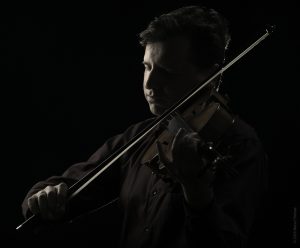 Violist Viacheslav Dinerchtein has appeared as soloist with orchestra, in recitals and chamber music concerts throughout North and South America, Europe and Asia, including venues such as Kennedy Center (Washington), Carnegie Hall (New York), Chicago Cultural Center, Spoleto Music Festival (Italy), the Niagara Music Festival (Canada), Palacio de Bellas Artes (Mexico City), Teatro Colon de Bogota (Colombia), Sociedad Filarmónica de Lima (Peru), International Viola Congresses (USA, South Africa, Germany, Portugal, Italy), among numerous others. Protagonist of TV and radio broadcasts, dedicatee of several compositions for viola, among them winners of competitions for composers, Dinerchtein is recognized for his efforts to popularize the unattended viola repertoire. His recording of the complete viola sonatas by Weinberg is set to be released in a centenary edition by Solo Musica (Sony Music). Former member of the Lipkind String Quartet, Dinerchtein is President of the Swiss Viola Society and editor for the music publishing houses Ovation Press and Amadeus Verlag.
Violist Viacheslav Dinerchtein has appeared as soloist with orchestra, in recitals and chamber music concerts throughout North and South America, Europe and Asia, including venues such as Kennedy Center (Washington), Carnegie Hall (New York), Chicago Cultural Center, Spoleto Music Festival (Italy), the Niagara Music Festival (Canada), Palacio de Bellas Artes (Mexico City), Teatro Colon de Bogota (Colombia), Sociedad Filarmónica de Lima (Peru), International Viola Congresses (USA, South Africa, Germany, Portugal, Italy), among numerous others. Protagonist of TV and radio broadcasts, dedicatee of several compositions for viola, among them winners of competitions for composers, Dinerchtein is recognized for his efforts to popularize the unattended viola repertoire. His recording of the complete viola sonatas by Weinberg is set to be released in a centenary edition by Solo Musica (Sony Music). Former member of the Lipkind String Quartet, Dinerchtein is President of the Swiss Viola Society and editor for the music publishing houses Ovation Press and Amadeus Verlag.
Studied with his father Boris Dinerchtein, with Joseph de Pasquale (Master of Music, Peabody Conservatory, Johns Hopkins University), and with Roland Vamos (Doctor of Musical Arts, Northwestern University; diss. “Shostakovich Viola Sonata”). Born in Minsk (Belarus), Dinerchtein grew up in Mexico, and now resides in Switzerland with his wife and two children. He is an award-winning amateur photographer, certified chess trainer, and a semiprofessional card magician.
Presenters: Boguslawa Hubisz-Sielska (viola), Poland;
Annette-Barbara Vogel (violin), Canada
Accompanist: Mariusz Sielski (piano), Poland
Date: Tuesday Nov 20th, afternoon, GKV Reformed church;
Duration: 25 minutes
Programme:
Robert Fuchs (1847-1927): Sieben Fantasiestücke op.57 for violin, viola and piano
– Mäßig bewegt
– Langsam, getragen
– Mäßig bewegt
– Sehr gemütvoll
– Anmutig bewegt
– Lebhaft, zart
– Etwas bewegt
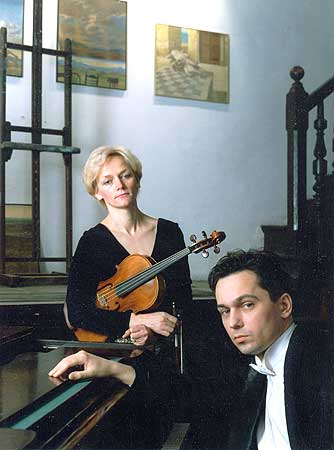
Boguslawa Hubisz-Sielska and Mariusz Sielski
Bogusława Hubisz-Sielska: Having completed her musical education at the Higher School of Music in Krakow she went on to participate in complementary master classes in Warsaw under Stefan Kamasa and in Munich under Kim Kashkashian. She has performed at numerous Polish Festivals, among others, Poznanska Wiosna Muzyczna, Spotkania Muzyczne w Baranowie Sandomierskim, Dni Kompozytorów Krakowskich. She has been performing for both Polish and international audiences. Her performances abroad took place in Austria, the Czech Republic, England, France, Germany, Hungary, Italy, Portugal, Russia, the Slovak Republic, Switzerland and the USA. She has also made TV and radio recordings in Poland, Austria, Germany, Vatican and USA and she has recorded some CD. She has arranged the Preludia taneczne (Dance preludes) of Witold Lutoslawski for viola. She has issued scores in Poland and Germany and has published in polish music periods. Composers Lexicon 1918-2000. Boguslawa Hubisz-Sielska sits on the jury panels of the national and international competitions. Her recording of the Niggun and Elegy of Rachel Knobler was presented in the Broadcasting Princeton as a Classical Discoveries. She is the founder-member of the Artistic-Association Muzyka Centrum. She is a senior teacher at the Academy of Music in Cracow, Germany and since the year 2001 she has been the head of The Lutoslawski Conservatory of Cracow, since 2009 president the Polish Viola Society.
Mariusz Sielski studied in Krakow under Ludwik Stefanski, Ewa Bukojemska and Janusz Dolny. His studies were followed by complementary master classes (with Alexander Jenner, Rudolf Buchbinder, Eliane Richepin and Fausto Zadra) and at the Munich Hochschule für Musik. He is well known as a soloist and chamber musician both in Poland and abroad. Highly acclaimed at the Polish National Piano Festival in Slupsk, he also took part at the CIMA festival in France. His tours abroad have included Austria, the Czech Republic, England, France, Germany, Italy, the Slovak Republic, Russia and Switzerland. Together with his wife he has made CDs recordings. He has been teaching piano playing class at the Academy of Music in Krakow since the completion of his studies.
Annette-Barbara Vogel (violin, Canada/Germany)
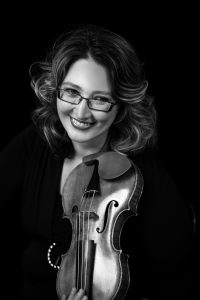
Annette-Barbara Vogel
A Full Professor and Head of Strings Western University, Annette-Barbara Vogel held university teaching positions in the US and Germany prior to arriving in Canada.
Vogel’s over 15 solo CDs are critically acclaimed for her “committed performances… [and] winning presence [of] her tone and delivery” (The Strad), “perfect intonation” (Gramophone), “authoritative and highly sensitive performances” (Music Web International), “formidable technique, and stunning musicality” (Wuppertaler Zeitung). Her 2011 release of Französische Komponistinnen is winner of the British International Record Review (IRR) Outstanding Award.
Annette-Barbara Vogel is the founder and Artistic Director of the string ensemble Magisterra Soloists (www.magisterra.com). Walter Levin (Basel), Herman Krebbers (Amsterdam), Henry Meyer (Cincinnati), Pieter Daniel, (Essen) and Dorothy Delay are among her most influential teachers. Vogel records for Avie, Bluegriffin, Cybele, Eroica Classical, and Harmonia Mundi Germany.
Presenter: Luca Sanzò and Camilla Insom (viola), Italy
Accompanist: N/A
Date: Saturday Nov 24th, afternoon, GKV reformed church
Duration: 30 minutes
Programme:
Garth Knox (Ireland, 1956) from Viola spaces for two (2006)
no. 1 – Beside the bridge
Gérard Pesson (France, 1958): Paraphernalia (2009)
George Benjamin (England, 1960): Viola, Viola
Garth Knox (Ireland, 1956) from Viola spaces for two (2006)
no. 8 – Up, down, sideways, round
 Camilla Insom and Luca Sanzò owe the beginning of their association to the existence of the Viola Association, in its Italian section. Founding members of the Italian Association of Viola – AIV, they met on the occasion of sharing the experience of the Board of Directors in the years up to 2016, and consolidated a friendship nourished by the same passion for musical things, for the role of viola and for today’s music. From this came the need for musical sharing not only organizing events and participating but also playing together, with great mutual satisfaction. The “Sanzò-Insom duo” therefore represents one of the results, and therefore one of the possible purposes, of the existence of our association.
Camilla Insom and Luca Sanzò owe the beginning of their association to the existence of the Viola Association, in its Italian section. Founding members of the Italian Association of Viola – AIV, they met on the occasion of sharing the experience of the Board of Directors in the years up to 2016, and consolidated a friendship nourished by the same passion for musical things, for the role of viola and for today’s music. From this came the need for musical sharing not only organizing events and participating but also playing together, with great mutual satisfaction. The “Sanzò-Insom duo” therefore represents one of the results, and therefore one of the possible purposes, of the existence of our association.
Presenter: Elmarie van der Vyver (viola)
Accompanist: Mathilda Hornsveld (piano)
Date: Thu Nov 22nd, afternoon, GKV Reformed Church
Duration: 25 minutes
Programme:
1. Niel van der Watt (1962-): Blomme van die Drakensberg (Wildflowers of the Drakensberg) for viola and piano;
– Varkblom (Arum Lily) – Zantedeschia albomaculata
– Kruidjie-roer-my-nie (Gurty-touch-me-not) – Melianthus villusus
– Krismisklokkies (Butter lily) – Littonia modesta
– Pynappelblom (Pineapple Flower) – Eucombus humilis
– Wilde Braambessie (Wild Blackberry) – Rubus cuneifolius
– Sewejaartjies (Everlastings) – Helichrysum squamosum
– Suikerbos (Sugar bush) – Protea simplex
2. Franco Prinsloo (1987-): Die Gebreekte Snaar (The Broken String) for viola and looping station) (world premiere)
3. Franco Prinsloo (1987-): Sonatina (viola and piano)
a. Introduzione
b. Scherzo
c. Song
d. Transcription
e. Finale
Program Notes:
Wildflowers of the Drakensberg – Niel van der Watt
My fascination with the wildflowers of the Drakensberg mountain range, dates from my first visit to the Champagne Castle area in 1979. On that trip, and in many subsequent ones, I gathered samples of yellow “Everlastings” and preserved them in glass test tubes, complete with cork stoppers. Later, I abandoned this illegal pillage and started taking photographs instead, while occasionally collecting seeds in order to try and grow the flowers at home. (These attempts, unsurprisingly, brought very little success!)
My love of wildflowers studiously avoids the scientific. I have never learned the botanical names and I am far more interested in the picturesque, descriptive, common names in Afrikaans and English. I own several scientific and coffee table books on wildflowers, which have raised my understanding of the plants and flowers, but my primary concern has always been with their beauty. I simply love the splashes of colour against the lush green background in summer or the khaki brown veld of the winter.
So, what to do with the photos and memories of innumerable hiking trips and walking holidays? For many years I have carried with me the idea of “setting flowers to music”, as though they were poems. I contemplated the example of “Pictures at an Exhibition”, and thought that I might write a “hiking theme” which could be interrupted by chance encounters with the flowers. This seemed a bit forced, so I settled on a “suite” that would attempt to encapsulate the character and personality of each of the flowers I chose. Subliminally, each flower is also linked to a person who shares similar characteristics of a particular flower, but these details will remain in the shadows.
I Arum Lily (Varkblom) – Zantedeschia albomaculata
This is a regal flower with an air of self-awareness. It is almost always encountered near water in the form of a stream, marsh or wetland. The joy of encountering an Arum Lily in the Drakensberg, creates the possibility and expectation of finding another just around the corner. The creamy-white, pointed cone has the shape of a pig’s ear, hence the Afrikaans name, Varkblom.
II Gurtie-touch-me-not (Kruidjie-roer-my-nie) – Melianthus villusus
The multiple small flower-heads that hang from a tall flower stem hides the detail of this unusual flower. Its common name derives from the fact that the flower is irritable and gives off an unpleasant smell when touched by an animal intending to eat it. However, if you approach this rather stand-offish specimen with respect and civility, your reward is a revelation of its intricate beauty and subtle colour.
III Butter Lily (Krismisklokkie) – Littonia modesta
These dainty little flowers are unashamedly exuberant and jolly. They bob their heads in the wind, dangle their heads against one another and make no excuse for attracting our attention. They are a joy to encounter around the time of a Southern Christmas, the height of summer.
IV Pineapple Flower (Pynappelblom) – Ecombus humilis
The brooding, virtually all-green Pineapple Flower stands on a solitary stem embedded on an even greener leafy carpet. They can occur in clumps but there is almost always a respectable distance between them. The tiny specs of yellow pollen are almost hidden under an ornate, green tropical hat (which could have been put to good use in a Mardi Gras parade!)
V Wild Blackberry (Wilde Braambessie) – Rubus cuneifolius
The little innocent, rose-like flowers belie the vicious thorns that are hidden on the plant’s stem. Wild Blackberry bushes form impenetrable patches which, should you try to cross them, will certainly result in loss of blood. Once nature has run its course with the delicate pink flowers a surprising reward appears: flavourful, sour-sweet berries. Delicious!
VI Everlastings (Sewejaartjies) – Helichrysum squamosum
The flowers that appear most abundantly in the mountains are the Everlastings, in all shapes, colours and sizes. They remain closed in cloudy weather and early morning, but even then they cannot hide their bright exterior colours. Everlastings retain their beauty long after they have been severed from the plant. What exemplary patience and fortitude!
VII Sugar Bush (Suikerbos) – Protea simplex
This is the only tree-flower I have included in this selection, and while there are others that are striking and impressive, they cannot compete with the calm grandeur of the King Protea. The Sugar Bush (protea simplex) is a much more modest specimen of the protea family and that is exactly why l love it so: regal but understated.
– – –
Die Gebreekte Snaar (The Broken String) – Franco Prinsloo:
“The first people of South Africa, Stone-Age hunters and gatherers from the mountains and the arid flats of the interior, did not survive the arrival of settlers from Europe. Within decades an ancient world of sorcerers, hunters and artists were lost forever, along with the stories they told”. (Bennun, 2004: cover)
In this lamentation for solo viola and loop pedal composer, Franco Prinsloo, explores the poetry of the nineteenth century /Xam poet, Diä!kwain, as archived in the acclaimed Bleek & Lloyd collection. “The poet laments the reality that he is disconnected from the place that was once his. The string with which he made the rain, has broken. His home has become unfamiliar to him and he is unable to hear its ‘rippling sound through the air’”. (Krog, 2004: 8)
The archive records eighty-seven legends, myths and other traditional stories of the ǀXam people in their now-extinct language. The stories were collected through interviews with various narrators, chief among them: ǀA!kunta, ǁKabbo, Diäǃkwain, ǃKweiten ta ǁken and ǀHanǂkasso.
These tales were written down and translated by Bleek and his sister-in-law Lloyd. Bleek died in 1875, but Lloyd continued transcribing ǀXam narratives after his death.
It is thanks to her efforts that some of the narratives were eventually published, which also includes sketches of rock art attributed to South African indigenous people, |Xam and some ǃXun narratives.
The composition, one in a series of works, aims to explore the natural inflection of the translated text (in this case the Afrikaans translation by acclaimed poet, Antjie Krog). The composition relies, much like vocal music, on the emotive emphasis of phrasing and natural narrative infelction of the text. The text is indicated bellow the music, not to be sung by the player, but rather to assist the instrumentalist in interpreting the musical language and to contemplate the text while performing. This allows the interpreter and listener to enter into a contemplation and conversation with the text musically.
The composer has set both English and Afrikaans translations of the text to music. This resulted in two very different and unique musical structures based on the unique rhythm and inflection of the respective spoken languages.
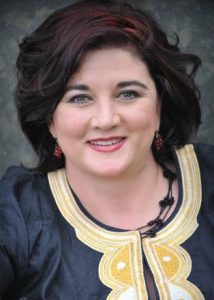 Elmarie van der Vyver is an instrumentalist that plays the viola and the violin in both the contemporary and in the historically informed performance practice (HIPP) idioms.
Elmarie van der Vyver is an instrumentalist that plays the viola and the violin in both the contemporary and in the historically informed performance practice (HIPP) idioms.
She started her studies on the violin at the age of six and completed a BMus degree at the University of Pretoria, followed by a MMus in viola performance at the Northwest University. Her teachers include Alan Solomon, Piet Koornhof, and most recently the Baroque specialist Antoinette Lohmann of the Conservatorium of Utrecht in the Netherlands.
Elmarie has been active as soloist and chamber musician. She has also been active as member of most of the main orchestras in Gauteng for many years. She performs at many of the arts festivals in South Africa on a regular basis. She currently teaches viola at the University of Pretoria. She also teaches privately and adjudicates at eistedfodds, music festivals and competitions.
She has attended numerous masterclasses and courses and played for the recordings of many artist’s CD’s.
Her interest in music lies with the development and performance of early music as well as the promoting and premiering of contemporary and new compositions. She has an appetite for unknown music – to find the music, put interesting programmes together and introduce audiences to music that was not known before.
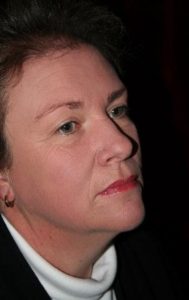 Mathilda Hornsveld graduated with a B Mus (Performers) from the University of Pretoria. She joined Pact (Performing Arts Council of the Transvaal) as a pianist in 1980 with the inception of its Permanent Opera Chorus. In this capacity, and subsequently as repetiteur, coach and backstage conductor and chorus master, she has worked on all major opera productions for the State Theatre until 1993. She returned as chorus master on an ad hoc basis from 1997 until the closure of the theatre in 2000.
Mathilda Hornsveld graduated with a B Mus (Performers) from the University of Pretoria. She joined Pact (Performing Arts Council of the Transvaal) as a pianist in 1980 with the inception of its Permanent Opera Chorus. In this capacity, and subsequently as repetiteur, coach and backstage conductor and chorus master, she has worked on all major opera productions for the State Theatre until 1993. She returned as chorus master on an ad hoc basis from 1997 until the closure of the theatre in 2000.
During her tenure as Chorus Master, she also appeared as assistant conductor for various musicals, conducting some performances every week.
She worked nationally as a freelance coach, chorus master and adjudicator of choral competitions.
She has conducted two productions of Fiddler on the Roof in Bloemfontein – one for Pacofs and the other for Unisi Girls High School. During her time at the State Theatre she did two workshop operas, The Medium by Menotti and Savitri by Holst. She also conducted productions of La Traviata and Fledermaus in Windhoek.
Since 1993 she has worked as an accompanist at Pretoria Boys High School where she also conducts their bi-annual musical productions.
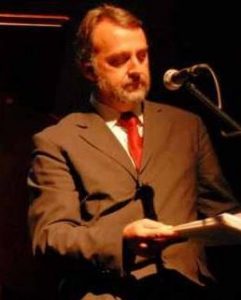 Born into a family of teachers, Niel van der Watt attended high school in Pietersburg (now Polokwane) in South Africa. After matriculating in 1980 he studied at the University of Pretoria, where he attained the BA Ed(Mus), BMus(Hons) cum laude and an MMus in Composition.
Born into a family of teachers, Niel van der Watt attended high school in Pietersburg (now Polokwane) in South Africa. After matriculating in 1980 he studied at the University of Pretoria, where he attained the BA Ed(Mus), BMus(Hons) cum laude and an MMus in Composition.
In 1997 he completed his Doctorate in Musicology at the University of South Africa with a doctoral dissertation on the life and works of the British composer Gerald Finzi.
After his military service in the old South African Defence Force, he joined the staff of Pretoria Boys High School, a prominent South African public school, where he is currently head of the Music Department and conductor of both the orchestra and Dixie Band. While he is a full-time teacher, he dedicates much of his time to composition. Van der Watt has also arranged a significant amount of traditional African music for choir as well as setting leading Afrikaans poetry to music, including the works of Antjie Krog and N.P. van Wyk Louw.[1]
While van der Watt’s early works show the influence of late romanticists like Rachmaninoff and Fauré, his mastery of harmony and counterpoint reveals a deep understanding of and reverence for the great master Johann Sebastian Bach. This, offset by a keen appreciation for jazz, rock and traditional African music, has made his oeuvre especially distinctive. A key work illustrating this is the De-Commercialised American Christ’s Mass (1995), which employs variations on popular Christmas carols to form a witty yet reverent incarnation of the Roman Catholic Low Mass
His works have been performed in places as far flung as Russia, Réunion and Hong Kong. He considers himself to be a poly-stylist.
 Composer Franco Prinsloo creates in a diverse variety of styles including choral, classical contemporary, new music, cabaret and theatre as well as pop music and electronica. He has composed and directed extensively for the stage including Maanmond (2009) Boegoe vannie liefde (2010) Pygmalion (2011) A Dolls House (2012) Skroothonde (2013) A Clockwork Orange, Marat/Sade (2014) Kind(s)(2015), CODE (2015) Mosioua (2016) and African Gothic (2017) to name but a few highlights. He has been the Musical Director for the Nedbank Arts and Culture Trust performing arts Scholarships from 2014 – 2016. He is an active composer in the new music scene in South Africa including The Horizons Project choir and the Paz Consort. He has commissioned by prominent choirs including The Akustika Chamber Singers, The University of Johannesburg Choir, The Potchefstroom University Choir, The University of Pretoria Camarata, The Jacaranda Childrens choir, The Molen Kórus, Cor di Juni Santa Christina, The Ladinia Women’s Chorus and the University of Pretoria Youth Choir. Prinsloo is also the conductor of his own three choirs. More notably his choral piece Pula, Pula! (from his musical “Naledi – an African journey”) was commissioned by the NWU PUK Arts for the Kings Singers to be performed in their programme in 2017. His compositions are frequently chosen as prescribed works at choral eisteddfods and competitions. A selection of his choral music is published at Helbling Verlag and available worldwide online. His own discography include: “Prima Materia” with his duo Duo Solvtio, an avant garde exploration with fellow composer Andre van Rensburg; “Die Ryke dwaas” a solo album of piano contemplations, “Sonder merkwaardige klank” a series of art songs with Netanja Brink, “Mosiuoa” a stage soundtrack of an multi-lingual adaptation of shakespeare’s Hamlet, “Nokturnes” a collection of art songs performed by soprano Magdalene Minnaar, “The Imaginary Musical” a cabaret, the international collaboration “In/Between” and “South African Choral Music Vol. 1”, “Noodluik” for Soprano, harp, clarinet and cello, and “Sunnyside Suites” work from the sound installation with the same title. All of the above mentioned recordings are available worldwide on Apple Music, iTunes, Deezer, CD BABY and more.
Composer Franco Prinsloo creates in a diverse variety of styles including choral, classical contemporary, new music, cabaret and theatre as well as pop music and electronica. He has composed and directed extensively for the stage including Maanmond (2009) Boegoe vannie liefde (2010) Pygmalion (2011) A Dolls House (2012) Skroothonde (2013) A Clockwork Orange, Marat/Sade (2014) Kind(s)(2015), CODE (2015) Mosioua (2016) and African Gothic (2017) to name but a few highlights. He has been the Musical Director for the Nedbank Arts and Culture Trust performing arts Scholarships from 2014 – 2016. He is an active composer in the new music scene in South Africa including The Horizons Project choir and the Paz Consort. He has commissioned by prominent choirs including The Akustika Chamber Singers, The University of Johannesburg Choir, The Potchefstroom University Choir, The University of Pretoria Camarata, The Jacaranda Childrens choir, The Molen Kórus, Cor di Juni Santa Christina, The Ladinia Women’s Chorus and the University of Pretoria Youth Choir. Prinsloo is also the conductor of his own three choirs. More notably his choral piece Pula, Pula! (from his musical “Naledi – an African journey”) was commissioned by the NWU PUK Arts for the Kings Singers to be performed in their programme in 2017. His compositions are frequently chosen as prescribed works at choral eisteddfods and competitions. A selection of his choral music is published at Helbling Verlag and available worldwide online. His own discography include: “Prima Materia” with his duo Duo Solvtio, an avant garde exploration with fellow composer Andre van Rensburg; “Die Ryke dwaas” a solo album of piano contemplations, “Sonder merkwaardige klank” a series of art songs with Netanja Brink, “Mosiuoa” a stage soundtrack of an multi-lingual adaptation of shakespeare’s Hamlet, “Nokturnes” a collection of art songs performed by soprano Magdalene Minnaar, “The Imaginary Musical” a cabaret, the international collaboration “In/Between” and “South African Choral Music Vol. 1”, “Noodluik” for Soprano, harp, clarinet and cello, and “Sunnyside Suites” work from the sound installation with the same title. All of the above mentioned recordings are available worldwide on Apple Music, iTunes, Deezer, CD BABY and more.
Prinsloo extends beyond the boundaries of his own expressive medium and in 2015 had a sold out solo photographic exhibition at the Artlovers1932 gallery in Pretoria. His sound installations has been featured in notable South African galleries including the Johannesburg Art Gallery in Richardt Strydom’s solo exhibition ‘Bleek’ and his sound work for found sound, poets, voice and marimba “Sunnyside Suite” during the 2016 Aardklop National Arts Festival. He also participated in a group exhibition with sound art and video installation at Fried Contemporary in 2017 in “Urban Impressions” He seeks to create through interdisciplinary collaboration and exploration. Prinsloo explores sound possibilities and often builds his own instruments (the XENOPHONE – a bowed metal instrument) or de-constructs/modifies/destroys old instruments, especially old found piano’s notably as part of the experimental spoken word trio “Dooie Diere” Recently he composed a musical “Naledi an African journey” which had its debut in February 2016 both at the South African State Theatre and at the Choralies festival in France. The work will be performed in April 2018 by the Cor di Juni Santa Christina in the Val Gardena, Italy. In March 2016 he underwent a successful international concert tour to Hong Kong and Singapore with Soprano Jessica Ng and Harpist Judy Ho performing his original compositions to great acclaim. The production has since also been staged at the Aardklop Festival in South Africa. Prinsloo presented new music for Soprano and harp at the 2017 International Harp Congress in Hong Kong and also recorded a new album of the same music with local musicians. In 2019 a new opera “The Book of Thel” in collaboration with Pieter Bezuidenhout will debut at the Black Box theatre in Hong Kong. “Prinsloo assimilates and unites disparate traditions within his own idiom” – Paul Boekkooi, South African Art Critic.
Presenter: Ursula Skaug (viola) Netherlands / Norway / Italy
Accompanist: Het Tollens Ensemble, conducted by Marten Sijbrandij
Date: Friday Nov 23rd, afternoon, main stage;
Duration: 15 minutes
The Leo Smit viola concerto is a rare gem of the Dutch viola repertoire.

Ursula Skaug
Ursula Skaug (16/3/1997) received a broad musical training; next to violin and piano lessons, she was a member of the Musicanti concert choir at the Academy of Vocal Arts in The Hague. She started learning the viola with Julia Dinerstein at the Hellendaal Violin Institute in Rotterdam, and currently studies at the Royal Conservatory of The Hague with Mikhail Zemtsov. She had masterclasses with (among others) Jennifer Stumm, Francien Schatborn, Asdis Valdimarsdottir, Gavriel Lipkind, Alexander Zemtsov, Geneviève Strosser, Isabelle van Keulen and Nobuko Imai. Ursula received the main prize at the Maassluise Muziekweek, the first prize at the Britten Altvioolconcours 2013 and a second prize at the Prinses Christina Concours 2016 Rotterdam. She had solo appearances with the Concerto Grosso Ensemble, Britten Youth String Orchestra and the Delft Symphony Orchestra. Ursula is experienced in chamber music, having participated in the yearly Chamber Music Atelier Delft, where she was coached by Vera Beths, Dmitry Ashkenazy, Benzion Shamir and Edith van Moergastel. In October 2016 she premiered a work for solo viola by Sebastian Diakakis Nilo at the International Viola Congress in Cremona. Ursula plays on a Daniël Royé viola built for her in 2017.

Het Tollens Ensemble

